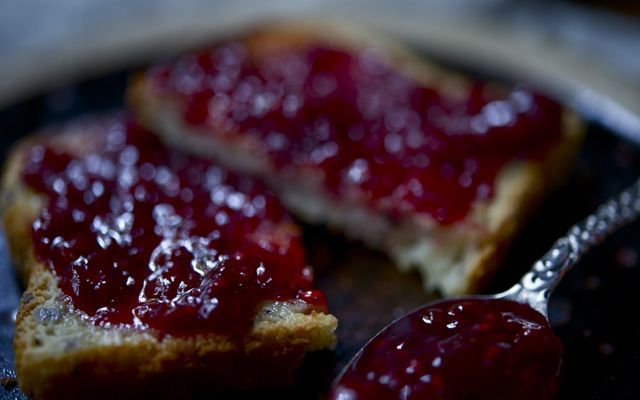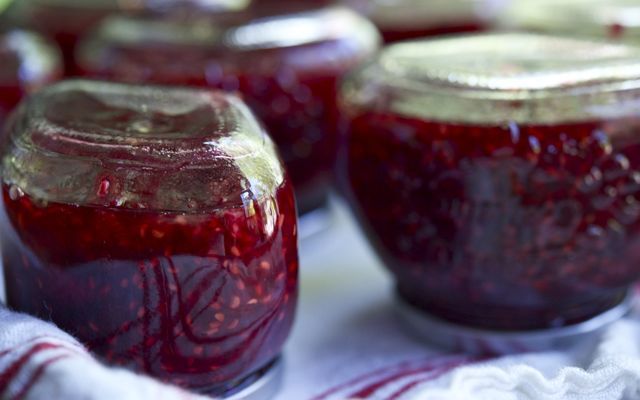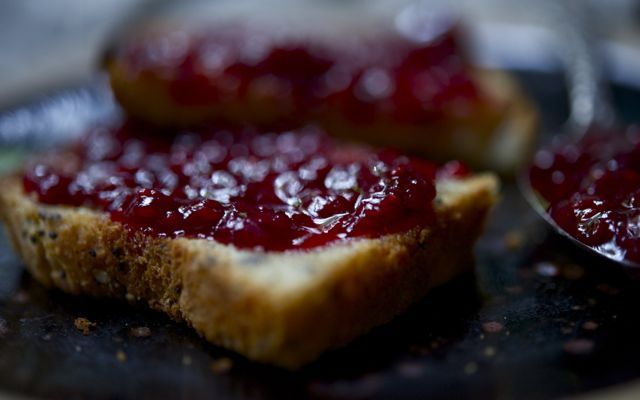7.23.12 Jam On: Summer Giveaway

photos by gluttonforlife
I am not so different from the beasts of the field and forest. Even in this heat, and with all of summer's bounty making it seem that we will never lack for food, we're thinking ahead to those cold, barren months. The squirrels are stockpiling pinecones, the mice are hiding seeds, and I am preserving fruits, vegetables and herbs in a variety of ways. I buy so much fruit at the local farmers market that I am officially known as a good customer and receive certain perks. This week that meant 10 pints of free raspberries deemed too soft to sell but really in absolutely perfect condition. That very same day I cooked them down and put them up—their sweet essence, garnet hue and soft, floral fragrance stowed away for a wintry delight. I've done the same with yellow plums, apricots, gooseberries and strawberries, so I've got quite the collection going in my basement. And it would be my pleasure to share some of it with one of my readers. Just leave a comment before Sunday the 29th at 6pm, and I'll select a winner at random to be announced next Monday the 30th.

red rover, red rover, let berry come over
I used a prize-winning recipe from Britain's Hugh Fearnley-Whittingstall, whose River Cottage books and television series have come to define a rural-sustainable way of life I so admire. Like much of his cooking, this jam is simple yet does much to highlight the pure flavor and magic of its ingredients; in this case, just raspberries, relatively little sugar and a bit of pectin. Lightly boiled for a loose texture, it falls under the category of "fridge jams"—a soft-set preserve with a fresh, tangy flavor that keeps well in the pantry but must be refrigerated upon opening. Naturally, you'll want to start with the best berries possible. Hugh recommends you aim for a mixture of ripe and almost-ripe fruit, preferably still warm from a hot, dry day in the field. Raspberries are such pushovers. A spoonful of sugar and a splash of cream and they give it up, releasing their scarlet juices and sultry perfume without the least resistance.

a jarring effect
This easy canning method that requires no boiling of the jars is not one often touted in this country, but I've used it frequently with much success. (As always, I recommend Pam Corbin's
The River Cottage Preserves Handbook for this and other excellent recipes.) I wash my jars with very hot, soapy water and then place them on a newspaper-lined baking sheet in a 250-degree oven to heat up/sterilize while I make my jam. The lids I bring to a boil in a saucepan of water, and then leave at a slow simmer until ready to use. As long as you pour and cap the preserves while they are still above 195 degrees, your jars should seal safely. If any don't seal, you can always reprocess them, or stick them in the fridge and enjoy them now rather than later.

a toast to you
Raspberry jam is wonderful stirred into yogurt; muddled with some mint at the start of a delicious gin cocktail; plopped on top of meringue discs with whipped cream; or whisked into crème fraîche and chilled in little cups for a rich and sophisticated dessert. Raspberry jam on toast is perhaps the best of all. It's one of my favorite ways to spread the love.
Raspberry Fridge Jam
lightly adapted from The River Cottage Preserves Handbook; makes about seven 8-oz jars
-
— 3 pounds, 6 ounces perfectly ripe raspberries
-
— 3 3/4 cups granulated sugar
-
— 1 1/2 teaspoons powdered pectin
Heat the oven to 250 degrees.
Line a baking sheet with newspaper and set aside.
Wash your glass jars with hot soapy water, rinse well and place right-side-up on the baking sheet. Place in the oven to heat up as you cook your fruit.
Place lids in hot water, bring to a boil and then hold on low heat until ready to cap jars.
In a medium bowl, blend together the sugar and the pectin.
Pick over the raspberries very carefully, discarding any leaves, stems or rotten bits. Place half of the fruit into a preserving pan and use a potato masher to coarsely crush it. Add the remaining fruit and sugar mixture (this will look mouthwateringly good).
Stir over low heat to dissolve the sugar. Bring to a rolling boil, then boil for exactly 5 minutes. (If you prefer a firmer jam, continue boiling at this stage for a further 2-3 minutes.) Remove from the heat, stirring to disperse any scum.
It is important to pour and cap this low-sugar jam quickly, but you must allow it to cool just a little first (give it 5 or 6 minutes) to prevent all those seeds from rushing to the top of the jar. Take lids out of hot water and dry with a clean towel. Remove jars from oven and fill with hot preserves. Wipe rims with a clean cloth and seal immediately with lids. Place tray of filled jars on a level spot where it can remain undisturbed for 6 hours.
After 6 hours (or more), check jars to make sure seals have formed. Any that do not have a firm seal should be refrigerated. The rest can go into cool storage.
Use within one year and, once opened, store in the fridge.
 Download Recipe
Download Recipe




 Download Recipe
Download Recipe






29 Comments